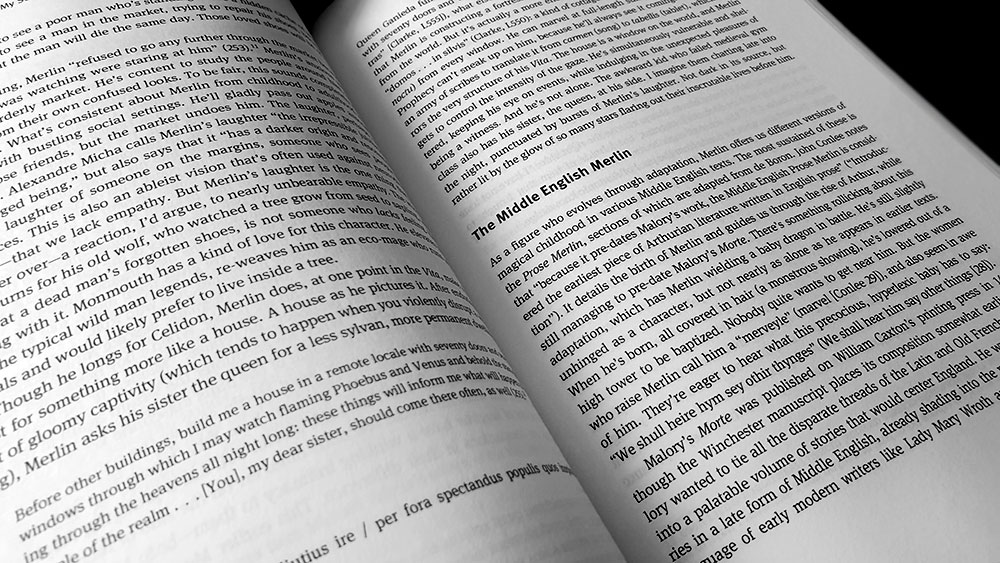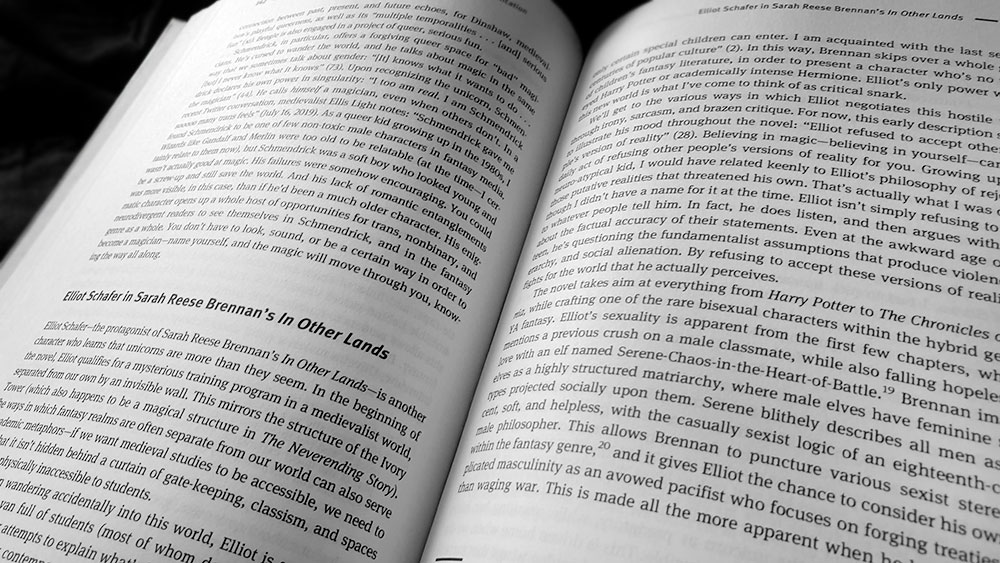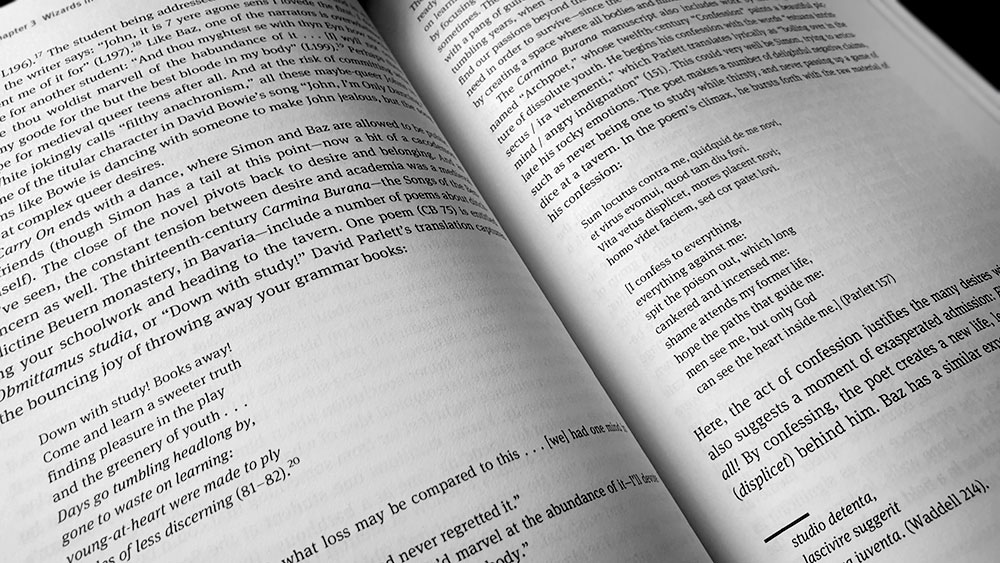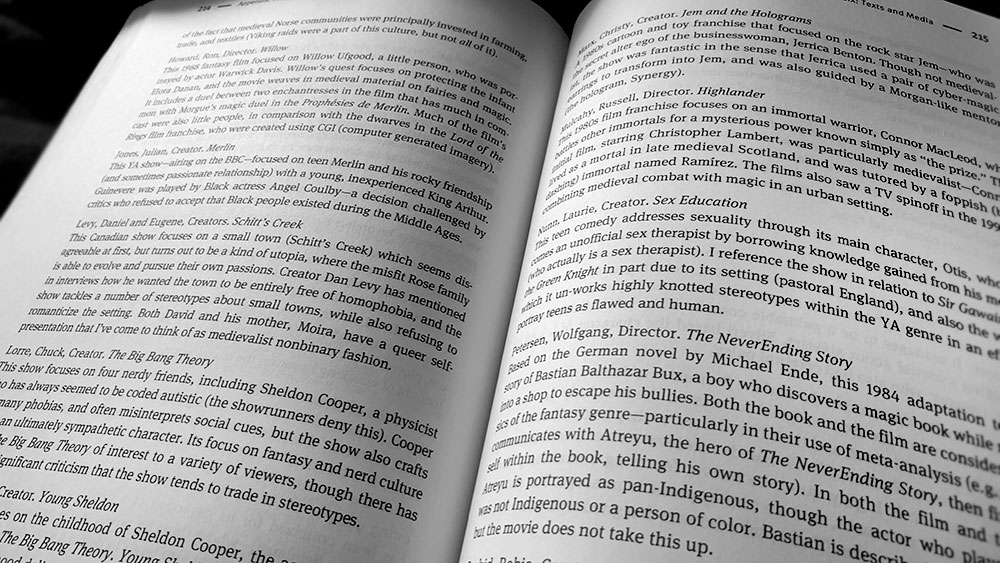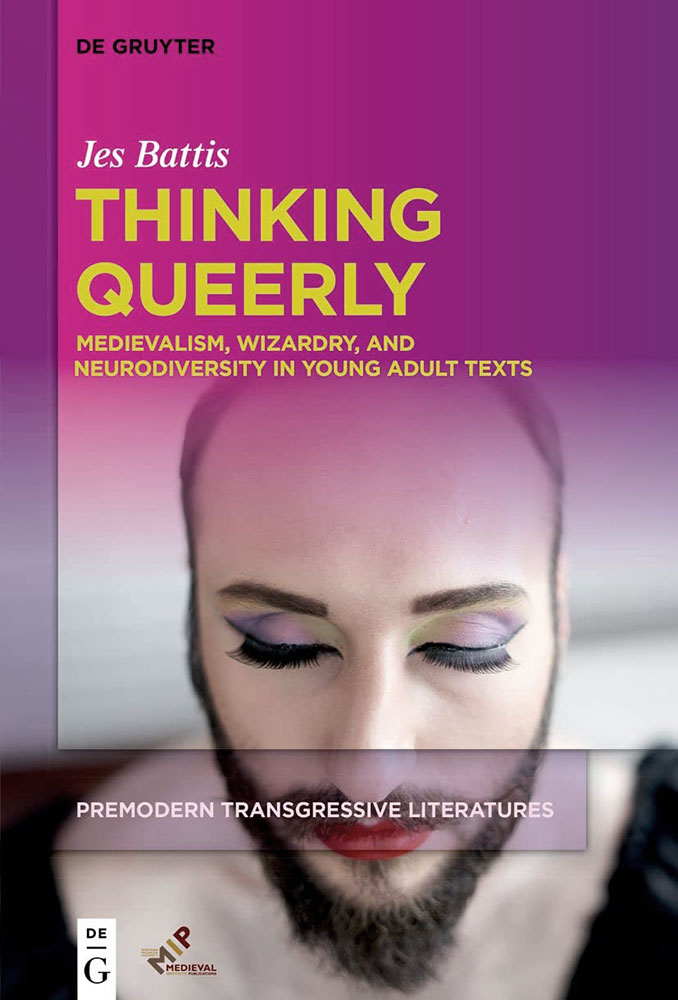 Jes Battis teaches literature and creative writing University of Regina, Canada, and has written a number of contemporary fantasy books, including two series with Penguin imprint Ace: Occult Special Investigator (Tess Corday is a paranormal detective working in Vancouver and the Fraser Valley) and, as Bailey Cunningham, Parallel Parks (a group of graduate students discover a parallel dimension at the heart of the city of Regina). The genesis of Thinking Queerly came during a semester which saw Battis teaching Chaucer during the day in one session and Buffy the Vampire Slayer in another at night, with the themes of youth and medievalism being productively blurred. As Battis notes, this is emblematic of Carolyn Dinshaw’s idea of medievalism’s asynchrony in which different timeframes and temporal systems collide in the now, in the queer middle. Battis found a link between these medieval temporal worlds through a third class they were teaching that focussed explicitly on teen fiction, with the teen wizard and his vampire boyfriend of Rainbow Rowell’s novel Carry On bridging the medieval and the medievalist. For Battis, medievalist young adult fiction locates the intermediacy of adolescence in what Jeffrey J. Cohen and Eileen Joy have defined as the medieval middle, the liminal space within which definitions merge and break down, where monsters, and wizards, lurk.
Jes Battis teaches literature and creative writing University of Regina, Canada, and has written a number of contemporary fantasy books, including two series with Penguin imprint Ace: Occult Special Investigator (Tess Corday is a paranormal detective working in Vancouver and the Fraser Valley) and, as Bailey Cunningham, Parallel Parks (a group of graduate students discover a parallel dimension at the heart of the city of Regina). The genesis of Thinking Queerly came during a semester which saw Battis teaching Chaucer during the day in one session and Buffy the Vampire Slayer in another at night, with the themes of youth and medievalism being productively blurred. As Battis notes, this is emblematic of Carolyn Dinshaw’s idea of medievalism’s asynchrony in which different timeframes and temporal systems collide in the now, in the queer middle. Battis found a link between these medieval temporal worlds through a third class they were teaching that focussed explicitly on teen fiction, with the teen wizard and his vampire boyfriend of Rainbow Rowell’s novel Carry On bridging the medieval and the medievalist. For Battis, medievalist young adult fiction locates the intermediacy of adolescence in what Jeffrey J. Cohen and Eileen Joy have defined as the medieval middle, the liminal space within which definitions merge and break down, where monsters, and wizards, lurk.
Battis argues that the wizard, with their exceptional abilities and a sense of otherness, can serve as a metaphor for neurodivergent experiences and highlights the similarities of queerness and neurodiversity in which viewing the world differently and fitting into societal expectations can be challenging. To this end, they bookend Thinking Queerly with paeans to two specific wizards: opening first with a chapter on Merlin, and then ending with an epilogue about Gandalf. Both wizards are cut from the same wizard cloth, being perpetual outsiders who are hard to pin down. They are both gifted with a hyperawareness that is twinned with a hypersensitivity that necessitates their occasional self-imposed exile from public life.
In their second chapter, Battis turns to what they identify as modern medievalist heirs to Morgan le Fay, prefacing this exploration with a thorough survey of her appearance in early texts the Vita Merlini and the Vulgate, as well as the later Les Prophéties de Merlin and Sir Gawain and the Green Knight. Informed by Carolyne Larrington’s essential study of Morgan and her sisters, King Arthur’s Enchantresses, Battis depicts her as a rebel against the magical establishment, an independent and ambiguous figure who defies classification. The witches identified by Battis as Morgan’s modern heirs are only designated as such by their status as witches and outsiders, rather than as villains. This is a shame and something of a disappointment as Le Fay’s particular strain of turpitude is such a core part of her appeal but is conspicuously absent in these scions. The two heirs do make for an odd assortment too, being Terry Pratchett’s imperturbable witch in training, Tiffany Aching, and Sabrina the Teenage Witch from Archie Comics (though viewed principally through the Netflix series Chilling Adventures of Sabrina, and, with some personal regret, not the 1990s sitcom starring Melissa Joan Hart). It is Sabrina that receives the lion’s share here, with the infinitely more interesting Tiffany sadly being deduced to a mere handful of pages.
Battis turns to that mainstay of young adult fantasy, the magical school, for their third chapter. Blessedly, little time is wasted on mouldy old Hogwarts, which is usually merely mentioned only in passing, and instead the case studies are drawn from Ursula Le Guin’s Earthsea series, Lev Grossman’s The Magicians and its sequels, and Rainbow Rowell’s Carry On (not to be confused, as I initially was, with the bawdy English series of cinematic farces, but rather a fan-fiction inspired remix of the tropes of Harry Potter). Sadly, Le Guin’s wizard school on the island of Roke doesn’t get much coverage here and the focus is on the two more recent examples from Grossman and Rowell, with Battis providing thorough analysis of these stories. Perhaps the most valuable device that Battis employs here is comparing these fictional schools to modern academia, drawing comparisons between the experiences of the characters and those of contemporary students in medieval studies. Indeed, throughout Thinking Queerly, it is often when Battis provides anecdotes from the classes they have taught that the central premise really shines, seeing how these tales both ancient and modern can be made to relate to contemporary queer and/or neurodivergent students.
Battis is well equipped for the final chapter discussing Sir Gawain as a young adult fiction protagonist, having written a 2023 urban fantasy Arthurian novel, The Winter Knight, in which the lead character is a reincarnation of Gawain. This isn’t merely focussed on recent treatments of the character, but goes all the way back to the anonymous late 14th-century poem, Sir Gawain and the Green Knight, with Battis highlighting the hero’s youthful and innocent qualities as the youngest of King Arthur’s knights. Gawain is as metaphorically green as Sir Bertilak, the Green Knight, is literally so-hued, with his youth being one of his most defining characteristics; someone who has “always been a YA figure” as Battis says. Like a modern Young Adult hero, Gawain is in the midst of becoming himself, discovering his wants and values, and how to find a space between his own desire for independence and the rules of the society within which he exists.
Moving past the aforementioned Gandalf epilogue, Battis concludes with a substantial appendix of texts and media, fifteen pages in all, listing not just medieval sources, each with a paragraph long blurb, but with a section on Young Adult novels, and another on media such as films and television series. The latter category is pretty broad and welcoming, featuring things one might expect, Labyrinth, Willow, and Buffy, but also outliers such as Young Sheldon, Community, and Hannah Gadsby’s comedy special Douglas.
While this may reflect the biases of the reviewer, Thinking Queerly is most interesting when it is considering the medieval rather than the medievalist. The link between the blueprints and their successors may be worthy of consideration, but it often emphasises the strength and depth of the originals, with modern medievalist interpretations being poor facsimiles. The theme of finding neurodivergent kin amongst literature’s magical cast of characters is an interesting one that offers a particularly unique selling point, even if it sometimes feels like the characteristics of almost anyone mentioned can be interpreted as examples of neurodiversity. Sans appendix, index and bibliography, Thinking Queerly runs to 202 pages of body copy, and is presented in De Gruyter’s usual house style and bound in a fetching magenta hardback.
Published by de Gruyter
